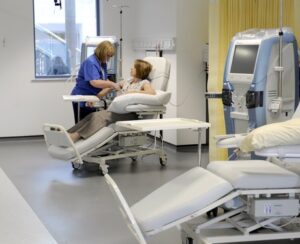Infections are a significant cause of disease among patients that must visit dialysis care centers. These infections are commonly referred to as health care–acquired infections, and as severe as they can be, they are, for the most part, preventable.
While the numbers can vary, about 500,000 people are being treated in dialysis care centers each year in the U.S. According to the National Kidney Foundation, infections are one of the most common causes of death among these patients.
One reason for this is that many of these people have weakened immune systems. Further, because so many of these patients have a history of being treated with various antibiotics, they have developed antibiotic resistance far more than most other people.
This means that if they do develop an infection due to using one of these clinics, the likelihood that they will become sick, or possibly not recover, is exceedingly high, simply because the antibiotic treatments available may not work.
Further, COVID has made the situation even worse. According to the New York Times, one of the first people to die from the virus in the U.S. was a Washington State dialysis patient who frequently visited a dialysis clinic.
Infection Control in Dialysis Care Centers
Because infection control is always a key concern in these facilities, and most especially now due to COVID, the best course of action for those who manage dialysis clinics is to ensure they are cleaned and disinfected thoroughly and properly.
Among the ways to make this happen are the following:
- Create a list of high-touch surfaces throughout the clinic. These are surfaces that must be cleaned and disinfected each day, and in many cases, throughout the day. Use the list as a “punch list” to ensure all high-touch surfaces are cleaned each visit.
- Remember that surfaces must be cleaned first and then disinfected, a two-step process. Further, if the disinfectant dries on a surface, it must be cleaned again, and the disinfectant must be reapplied.
- Traditionally, the disinfectants used in dialysis centers are hospital-grade disinfectants. But today, due to COVID, only N-Listed disinfectants should be used. These disinfectants have been tested and approved by the EPA to eliminate the pathogens that cause the coronavirus.
- We suggest using color-coded cleaning cloths. Green cloths, for instance, should be used only for cleaning surfaces, red cloths for disinfecting. Further, cloths should be changed frequently. If changed when soiled, that is too late.
- If an electrostatic sprayer is used to disinfect the clinic, use these machines after surfaces have been cleaned and when patients and staff have left. These machines have proven to be highly effective at disinfecting large areas of a facility.
- Unique to dialysis facilities is a chalky residue that builds up on floors. This is from bicarbonate administration used in the dialysis process. This residue must be removed each cleaning visit to ensure a clean, healthy, and professional medical appearance.
- Floor care is crucial in dialysis clinics. With the bicarbonate residue removed, the floors should be mopped each visit. We always use fresh mops, an all-purpose cleaner, and change the mop water/solution frequently. Floors may also need to be disinfected on a regular schedule.
- For deeper cleaning, we recommend the floors be stripped and refinished two or three times per year. Once again, this helps ensure a professional medical appearance.
Cleaning workers should always wear gloves when working in dialysis centers and, due to the bicarbonate residue, it is often recommended they wear masks as well.
Further, if hiring a new cleaning contractor to maintain a dialysis center, managers should always take the time to thoroughly review the cleaning needs of the facility along with how the facility is used by staff and patients.
The more the contractor knows about the facility, the easier it is for the cleaning workers to keep it clean and healthy.
As always, we are here to help. Do you need a punch list of touch-points or a scope of work sample? Sign up for our newsletter and we will send you one.
Also, contact us at 732-901-5337 or click on our logo below. We’ll take care of it.




